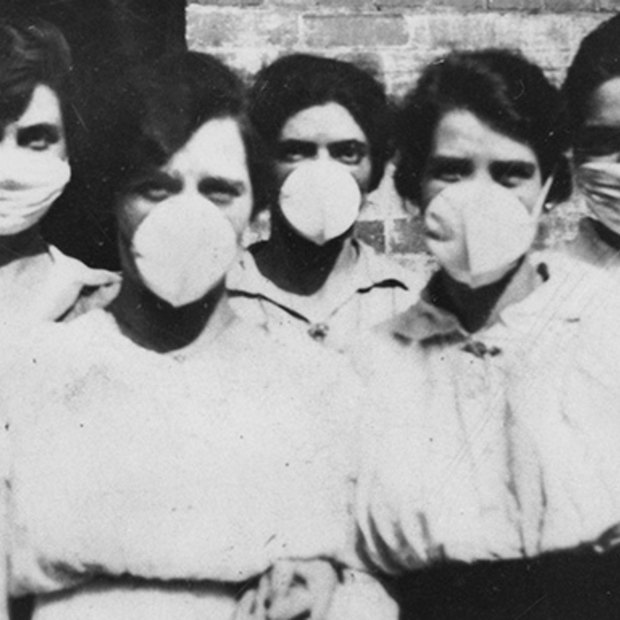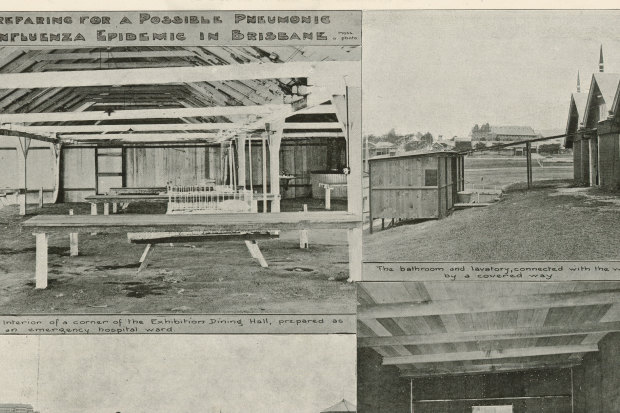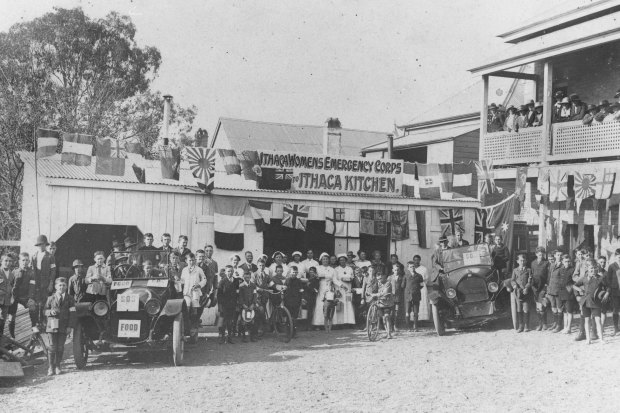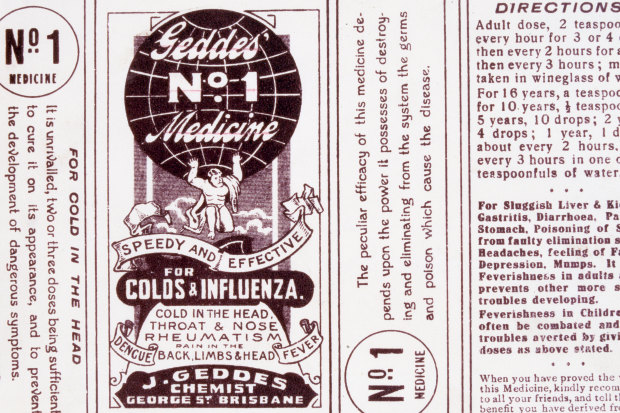This was published 5 years ago
The forgotten disaster: 100 years since the Spanish flu hit Brisbane
Brisbane suffered its worst ever natural disaster in 1919 when the Spanish Flu hit the city, killing over 300 people and affecting thousands. But 100 years later, the event has passed out of memory.
By Stuart Layt

Masks were made compulsory during the Spanish flu outbreak in Australia. Credit: National Museum of Australia
Hundreds of people dead, the city on lockdown, travel restricted and ships quarantined, communication services shattered and a terrified populace reeling from a fresh disaster so quickly on the heels of the horrors of total war.
But on this month's 100th anniversary of the Spanish flu hitting Brisbane, it’s unlikely many in the Queensland capital would even recognise the name of the disease, let alone the impact it had on the city.
Preparing for the worst
Australia had time to get ready for the Spanish flu, or pneumonic influenza, as it was called by health authorities at the time, due to its tendency to result in a serious secondary lung infection.
Millions of people had already died across the world as the flu spread, travelling home with soldiers returning from the crowded, filthy camps and trenches of World War I Europe.
Australia was not hit by the first bloom of the disease in 1918 but health authorities were grimly aware of the possibility of an outbreak as that many people returned from infected areas.
Home Secretary John Huxham was recorded in the Warwick Examiner and Times on January 25, 1919, detailing local preparations against the disease reaching the state.
“Facilities have been provided in Brisbane for the inoculation of persons against influenza, and should the necessity arise further depots will be established and the services of additional medical men requisitioned,” Mr Huxham is recorded as saying.
“Nothing has been left undone that could be done in anticipation of any possible emergency.”

A page from the Queenslander Pictorial supplement to The Queenslander 15 February 1919, showing Queenslanders stranded in NSW following the border being closed.Credit: John Oxley Library
That included suddenly closing the border with NSW just a few days later on January 28, leaving at least one train full of passengers stranded, as well as a number of former soldiers who had yet to return home from Sydney.
Queensland Library research librarian Christina Ealing-Godbold said it also caused particular trouble for border towns like Coolangatta.
“They stopped people travelling very swiftly but unfortunately they allowed people to pass goods back and forth over the border,” Ms Ealing-Godbold said
“They didn’t understand at the time that infection and germs could easily travel on people’s hands and even on items.
“Then you had situations where people had popped over to the Tweed for their groceries, as Coolangatta didn’t really have any shops at that time, and were stuck on that side of the border.”
Matthew Wengert, historian and author of City in Masks: How Brisbane fought the Spanish Flu epidemic in 1919, said there wasn’t even a very clear understanding at the time of what a virus was.
“People were being inoculated, there was a two-shot inoculation, but that was for bacteria which came with the pneumonia,” Mr Wengert
“Plenty of people who were inoculated still got the flu and some of them died.
“They thought it was spread through mosquitoes, flies, rats, and they did a big clean-up around the city, because they thought it might be associated with filth.”
Brisbane did its first ever burn off of rubbish as part of that process, stopping the long-standing practise of simply dumping rubbish in Moreton Bay.
Anti-mosquito measures were put in place and some streets and buildings were literally scrubbed with detergent.
Despite the preparations, the flu soon arrived.
The flu hits Brisbane
The first person to die in Queensland from the flu wasn’t a local - sailor Jack Fitzpatrick died from complications relating to the flu on April 30 after arriving in Brisbane on a steamship.

Page 25 of the Queenslander Pictorial, supplement to The Queenslander, 1 March, 1919, showing preparations for the Spanish Flu in BrisbaneCredit: John Oxley Library
Over the next few days cases were increasingly reported, starting with an army barracks at Kangaroo Point.
“The first cases were laundry workers, who may have gotten it off the soldiers,” Mr Wengert said.
“The military at the time was not outright hiding the fact but certainly trying to minimise the fact that soldiers were bringing the flu in.”
But it was the frontline medical workers who ended up in the firing line.
“Within a week there were dozens of cases, and nurses copped it hardest,” Mr Wengert said.
“By the end of the first week there were already 20 nurses in Brisbane General Hospital sick with the flu.
“At one point there were up to 80 nurses in Brisbane sick with the flu, and a few of them died.”
Because of their close contact with infected people nurses were highly represented among sufferer, but no part of the city was unaffected by the growing crisis.
“Everyone knew someone who was seriously sick or dying, or dead,” Mr Wengert said
“There was no part of Brisbane that wasn’t affected; every suburb, almost every street.”
Ms Ealing-Godbold said it was "quite widespread, and people in all sorts of different professions seemed to succumb to it".
In response to the crisis, two major quarantine zones were established where the worst cases were sent: one at Lytton to deal with cases from quarantined ships, and the other at the Brisbane showgrounds at Bowen Hills for the general public.
The annual show, which eventually came to be called the “Ekka” by Brisbane locals, was called off for the first time, after running uninterrupted all through WWI.
The only other time it would be called off again was in 1942, during WWII.
The usual fun of the annual show was replaced by the showgrounds quarantine site, which was the epicentre of the city’s flu crisis.
The centre had 400 beds where the most sick were sent, some by desperate staff at the city’s overrun regular hospitals.
“Doctors were told not to send anyone there unless they were very sick, so there were cases where people arrived and then died 15 minutes later,” Mr Wengert said.
“Every day you were there you would watch someone being taken out with a sheet over their face. Sometimes six or eight people a day.
“The whole place was saturated with misery and fear and death.”
But as in all disasters, the best of humanity began to shine through the darkest situation.
A quiet heroism
In the face of the flu threat, multiple community groups mobilised in an effort to tend to the sick and help prevent the spread of the infection.
Church groups were naturally involved but it was women’s groups who took the lead, combining their efforts into what was called the Women’s Emergency Corps.
Mr Wengert said they were mostly women who had served as emergency nurses during the war, and they now went street by street, house by house, to help those hit by a more insidious enemy.
“They cooked and they fed people and made sure they had water, and they cleaned them, because this flu was so severe you wouldn’t make it to the outhouse in the middle of the night,” he said.

Members of the Women's Emergency Corps at Ithaca, the modern Brisbane suburb of Red HillCredit: John Oxley Library
“These women knew they were dealing with the deadliest disease ever known, and they were going into these houses with just a face mask, a thin layer of fabric between them and the biggest killer in history.
“Their heroism was cooking and cleaning, making sure they drank some water and letting them know they weren’t alone.”
The doctors and nurses at the exhibition quarantine centre had to stay at the centre, to prevent them spreading the disease further.
Knowing that, Helen Huxham, the wife of the home secretary, volunteered herself to help treat the sick, staying for six weeks.
Meanwhile, the city started to grind to a halt, although most people tried to carry on as best they could.
The cutting-edge telephone service was disrupted because all the telephone exchange workers fell ill or avoided work.
Similarly all train and tram services were disrupted with a major driver shortage.
The state government passed legislation to force people not to crowd in the public transport that was left, with no one allowed to stand on trains and trams.
“I think people were terrified, that’s my reading,” Ms Ealing-Godbold said.
“Because it was striking people randomly, and especially striking strong young people, there was a great deal of nervousness as to who might be next.”
The city recovers
The city’s outbreak followed a very standard epidemic pattern, with a short sharp increase in cases, followed by a long tail of incidents.
In all, more than 300 people died in Brisbane alone from the disease, with estimates nearly 10,000 people fell ill during the crisis.
At the time the population of Brisbane was about 190,000, meaning if the disease were scaled up to the city’s population today it would kill more than 2000 in a period of six or eight weeks.
By the time July arrived the cases had started to ease but there were still sick people until the end of the year.
The flu prompted a number of bizarre firsts for the city. In addition to suddenly stopping its pollution of Moreton Bay, the city got its first open-air cinema, with several venues taking their roofs off to get around regulations preventing gatherings in enclosed spaces.
The popular boxing venue on the eventual site of the old Festival Hall also took its roof off to allow bouts to continue during the crisis.
A range of anti-flu measures were touted by snake-oil sellers and health authorities alike.

Geddes cold medicine label, prominent during the 1919 Spanish Flu outbreak in Brisbane.Credit: John Oxley Library
“People wore handkerchiefs over their mouths and they soaked them in all manner of things – eucalyptus oil, camphor oil, as well as using all sorts of home-made medicines in order to keep it at bay,” Ms Ealing-Godbold said.
“It was quite common across the city to smell that camphor or naphthalene everywhere.”
In addition to personal methods, health authorities set up “inhalation chambers" to stave off the flu.
“They were these rooms that were set up and people could go there and inhale the noxious gases which they thought helped with the flu,” Mr Wengert said.
“There were a number of them around the city and people could go and spend half an hour breathing in the gases, usually zinc sulphate, which apparently isn’t particularly harmful but it’s certainly not healthy.”
But as Brisbane recovered, the disease was beginning to rip through the rest of the state, moving west and north through developed cities over the course of the year.
Cairns was hit by December, and communities in the Torres Strait were struck with the disease in 1920, some of the last places in the world to see the flu.
In particular, Indigenous communities were hit disproportionately hard by the outbreak, especially the government settlement at Barambah, which later became the town of Cherbourg. In three weeks, 90 people died out of a population of just 600.
The forgotten disaster
In the aftermath of the worst natural disaster Brisbane has ever seen, people mourned those who had died and then moved on.
“People do call it the forgotten epidemic,” Ms Ealing-Godbold said.
“There were many accounts of the horrors of the Western Front and Gallipoli, whereas this was something that happened in suburbia, without any of the glamour of war.
“People got sick, they went home and they died.”
The flu killed more people worldwide than both world wars put together, but Mr Wengert believed the ongoing peace process in the aftermath of World War I contributed to overshadowing the impact of the flu.
“The flu had died down enough by July 1919 for the city to allow large public gathering to mark the signing of the Treaty of Versailles,” he said.
“So people were able to get out and celebrate that the war was officially over … they could have proper peace marches and celebrations just as the flu ended.”
One group of people who have never forgotten the Spanish Flu are disease and disaster experts, who still look to the worldwide event as an example of how an epidemic spreads.
Professor Gerard Fitzgerald from QUT’s Faculty of Health is a disease and disaster medicine expert and former Queensland Chief Health Officer.
He said the conditions surrounding the 1918 outbreak did not exist today but there were other factors at play.
“Our medicine is obviously a lot better today, so we would be much more on top of the disease itself,” Dr Fitzgerald said.
“But the other factor is the world has changed since 1919: 100 years ago by the time the ship got here you knew if there was Spanish flu on board.
“Now, if you’re on a jet and the flu has an incubation period of five days then if someone walks through Singapore airport coughing and sneezing, the disease will be in every country in the world within 24 hours.”
Dr Fitzgerald said the most important thing to come out of Brisbane’s flu crisis was an awareness of how deadly an epidemic could be.
“They estimate between 40 and 70 million people died around the world as a result of the flu,” he said.
“To put that in perspective, today around 70 million people die every year from all causes, so this would double the global death rate.”
“An outbreak (of influenza) will happen again. We’ve had 100 years of medical advancement since the last major one, but it is still the thing that most scares public health officials, I can tell you.”